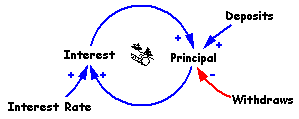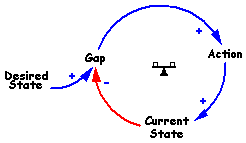Systems Thinking
An Operational Perspective of the Universe
Yes, I admit the title may be a bit presumptuous on my part.
I do have to start somewhere though, don't I? I suppose the difficulty
I have been having with this article is somewhat based on the
intimidation factor presented by the great minds that have evolved
our understanding to this point. Great minds such as Descartes,
Newton, Bertalanffy, Wiener, Bateson, and Forrester. And, should
I be so presumptuous as to believe I can add to what they have
wrought? So, with humility I continue.The Universe is! And, for some it is meaningful to seek an
understanding of the origins of the Universe. From my perspective
the meaningful question is, "How does it work?" This
is not to indicate that I have an answer. Yet, the answers we
find, and the understanding we develop, are shaped by the questions
we ask.Systems Thinking is, more than anything else, a mindset for
understanding how things work. It is a perspective for going beyond
events, to looking for patterns of behavior, to seeking underlying
systemic interrelationships which are responsible for the patterns
of behavior and the events. Systems Thinking embodies a world-view.
A world-view which implies that the foundation for understanding
lies in interpreting interrelationships within systems. Interrelationships
which are responsible for the manner in which systems operate.
Interrelationships which result in the patterns of behavior and
events we perceive.Descartes and Bacon provided us with an analytic framework
for understanding, and the scientific method. Newton, with the
discovery of the laws of motion and gravity, provided us with
a clockwork paradigm for understanding the universe. A paradigm
which is not so much wrong as it is incomplete. The Newtonian
paradigm embodies essentially a linear cause and effect relationship.
A paradigm which is reinforced by the way in which we view daily
events. The difficulty with this paradigm is that it provides
a very limited short term perspective for understanding how things
really work.When we go beyond the linear cause and effect paradigm to study
patterns of behavior and then to study the systemic interrelationships
among the parts of systems we develop a much deeper understanding
of the nature of the way things operate. An operational understanding
which can allow us to work with the system rather than against
it. An understanding which allows for the development of interventions
to create lasting change within the system, if that is the desired
intent.I have repeatedly referred to system(s) without an explicit
definition. The definition with which I have become most comfortable
is as follows.
through the mutual interaction of its parts.
The key part of this definition is that of interaction. A system
is much more than a heap or a lump. It is the interactions which
are responsible for the characteristics of the system, not the
parts. The interactions of the parts become more relevant to understanding
the system than understanding the parts.
Savings Account
Consider how we traditionally think about a savings account.
We put money in the bank and periodically we receive interest
on the money. This represents a very traditional linear cause
and effect relationship between principal and interest, which
is appropriate, to a point. The following diagram represents a
more complete way of viewing the relationships, and the system.
If this is your first introduction to systems thinking diagrams,
bear with me for a moment, for they're not nearly as difficult
as they might first seem. Introduction
to Systems Thinking might also be helpful.

Arrows between elements of a system represent the direction
of influence. Thus the arrow between Deposits
and Principal implies that Deposits
influence Principal. An influence arrow also
has either an "+" or an "-" affixed to it.
A "+" indicates the influence adds to while a "-"
indicates the influence subtracts from. Thus, the implication
of the influence between Deposits and Principal
is that as Deposits add to the Principal.
If Deposits decrease they will still add to the
Principal, only not so much. One should be careful
not to add implications that are not represented by the diagram.Withdraws also influence Principal,
yet in an inverse or opposite manner. That being, Withdraws
subtract from Principal.Additionally, Principal and Interest
Rate interact to create Interest, and
each of them act in a direct relationship. As Principal
or Interest Rate increase Interest
increases. Interest then adds to the Principal
causing it to increase further, and the cycle repeats.
Emergence
Systems exhibit characteristics which can not be found in any
of its parts. These characteristics emerge from the interactions
of the parts of the system. Consider the interactions in the previous
diagram. Principal and Interest Rate
interact to create Interest. Interest
then serves to increase Principal, which then
interacts again with Interest Rate to create
more Interest. The characteristic exhibited by
this system, which can not be found in any of its parts, is one
of growth. Principal and Interest
interact in a reinforcing fashion. The snowball rolling down hill
in the center of the diagram is intended to indicate that this
is a reinforcing structure.
Achieving Results
It should be rather obvious that things simply don't grow forever.
There is always a balance somewhere. Consider the following structure
which represents what is called a balancing loop.

In this representation there exists some Current State
which is assumed to be less than some Desired State.
The influence arrows indicate that the Current State
and Desired State interact to produce a Gap.
The interaction is such that as the Desired State
adds to the Gap and the Current State
subtracts from the Gap. This Gap
then influences Action intended to move the Current
State toward the Desired State. As Action
moves the Current State closer to the Desired
State the Gap decreases. A decrease
in the Gap adds less influence resulting in less
Action. When the Current State
reaches the Desired State the Gap
is reduced to zero and there is no longer an influence causing
Action. The emergent character of this structure
is one of balance as the structure promotes a balance between
initial differences. The balanced lever in the center of the structure
indicates it is a balancing structure.
The System and External Influences
There is only one system, the Universe. All other systems are
simply subsystems of this larger system. When we investigate interactions
it is essential to determine where to draw the boundaries to limit
consideration. In doing this there is always a trade-off. If we
excessively limit the domain of interactions considered, what
remains may be so narrow as to omit some of the relevant interactions
essential to understanding the system. If we make the domain of
interactions considered too broad, the system under consideration
is quite apt to be of such complexity as to limit our ability
to understand the interactions amidst the complexity.In the above reinforcing loop the interaction of Principal
and Interest was the object of the investigation.
Interest, Deposits, and Withdraws
appear as external influences on the system being considered.
It is understood that each of these external influences is actually
a component of some other subsystem. The choice was made to omit
considering the operation of these other subsystems to allow a
focus on the interaction between Principal and
Interest.The intent of investigating systems is to develop understanding.
Often the understanding is an emergent result of trial and error.
If the desired understanding isn't developing try expanding or
contracting the domain of consideration. As far as I can tell
there is no formula for determining what's appropriate. When understanding
emerges the domain of consideration is likely to be appropriate.
Identifying Reinforcing and Balancing Structures
Often when balancing loops and reinforcing loops are part of
a complex structures it is difficult to determine the types of
loops. The easiest way to make this determination is to count
the "-" signs. Simply move around the loop counting
the number of "-" signs. If there are zero, or an even
number, of "-" signs then it is a reinforcing loop,
otherwise there is an odd number of "-" signs and it
is a balancing loop.It is also important to realize that reinforcing loops can
create either growth or decline. Which is the case depends on
whether the interactions are increasing or decreasing the parts
of the system they influence. Reinforcing loops are also often
classified as virtuous or vicious depending on whether they are
moving the system is a desirable or undesirable direction.Balancing loops may begin with the current state being greater
than or less than the desired state. Depending on the initial
conditions a balancing loop may represent an increase in the current
state toward the desired state or a decrease in the current state
toward the desired state.
Interaction Delays
It is also important to note that there may be delays, possibly
of different durations, associated with the interactions between
the parts of a system. These delays will determine the length
of time it takes for the characteristics of the structure to become
evident.Consider the Savings Account example above. Interest is generally
created periodically rather than continuously. There is a delay
between Principal and Interest,
and after this delay, at some specific point in time, Principal
interacts with Interest Rate to produce Interest.
There is no apparent delay between Interest creation
and its effect of increasing Principal.
When dealing with intricate combinations of balancing and reinforcing
structures delays are responsible for creating characteristics
which are very nonlinear and often very counter-intuitive.
Archetypes
The reinforcing and balancing structures represent the first
two of a set of structures first postulated by Ludwig von Bertalanffy
in the 1930s. These structures were developed and finally labeled
as Archetypes by Peter Senge in his 1990 work entitled "The
Fifth Discipline: The Art and Practice of the Learning Organization."As I understand Bertalanffy's initial premise it was that there
are fundamental structures which act across all branches of science.
And, if one learns the structures, when transferring from one
discipline to another, much of the learning could be transferred.
When studying a new discipline one would simply have to learn
the labels on the structures in the new discipline. This was the
foundation of what was to become General Systems Teaching, but
ended up being called General Systems Theory due to a translation
error.
When I first came across this perspective I considered it rather
profound. Yet, as I pondered it for a time I rather resolved that,
how could it be any different? There is but one Universe. The
disciplines of science are a creation of ours, not the Universe.You can consider the balancing and reinforcing structures as
building blocks which can be combined in numerous ways to describe
more intricate interactions.
Deepa Singh
Business Developer
Web Site:-http://www.gyapti.com
Blog:- http://gyapti.blogspot.com/
Email Id:-deepa.singh@soarlogic.com
Deepa Singh
Business Developer
Web Site:-http://www.gyapti.com
Blog:- http://gyapti.blogspot.com/
Email Id:-deepa.singh@soarlogic.com
No comments:
Post a Comment